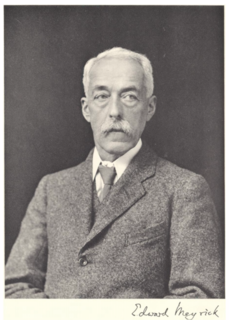
Edward Meyrick was an English schoolmaster and amateur entomologist. He was an expert on microlepidoptera and some consider him one of the founders of modern microlepidoptera systematics.

Pyraustinae is a large subfamily of the lepidopteran family Crambidae, the crambid snout moths. It currently includes over 1,400 species; most of them tropical but some found in temperate regions including both North America and Europe.
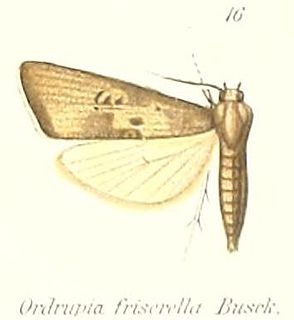
Copromorphidae, the "tropical fruitworm moths", is a family of insects in the lepidopteran order. These moths have broad, rounded forewings, and well-camouflaged scale patterns. Unlike Carposinidae the mouthparts include "labial palps" with the second rather than third segment the longest. With other unusual structural characteristics of the caterpillar and adult, it could represent the sister lineage of all other extant members of this superfamily. The genus Sisyroxena from Madagascar is also notable for its unusual venation and wing scale sockets.

Spilomelinae is a very species-rich subfamily of the lepidopteran family Crambidae, the crambid snout moths. With 4,132 described species in 340 genera worldwide, it is the most speciose group among pyraloids.

Crambinae is a large subfamily of the lepidopteran family Crambidae, the crambid snout moths. It currently includes over 1,800 species worldwide. The larvae are root feeders or stem borers, mostly on grasses. A few species are pests of sod grasses, maize, sugar cane, rice, and other Poaceae. The monophyly of this group is supported by the structure of the tympanal organs and the phallus attached medially to the juxta, as well as genetic analyses.

Imma is a large genus of moths in the obtectomeran "micromoth" family Immidae. This is the type genus of its family. They are widespread in the tropics, with most species occurring between the Himalayas and the Oceanian region; the genus is furthermore plentiful in the Neotropics, but not very diverse in the Afrotropics.

Termessa nivosa is a moth of the subfamily Arctiinae first described by Francis Walker in 1865. It is found in the Australian states of New South Wales, South Australia and Victoria.

Termessa shepherdi, the shepherd's footman, is a moth of the subfamily Arctiinae. The species was first described by Newman in 1856. It is found in the Australian states of New South Wales, Victoria and Tasmania.

Termessa is a genus of moths in the subfamily Arctiinae The genus was described by Newman in 1856.
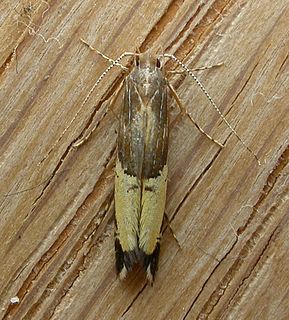
Labdia is a genus of moths in the family Cosmopterigidae.

Macrobathra is a genus of moths in the family Cosmopterigidae. Most species are endemic to Australia.

The Depressariinae – sometimes spelled "Depressiinae" in error – are a subfamily of moths in the superfamily Gelechioidea. Like their relatives therein, their exact relationships are not yet very well resolved. It has been considered part of family Elachistidae sensu lato or included in an expanded Oecophoridae. In modern classifications they are treated as the distinct gelechioid family Depressariidae.
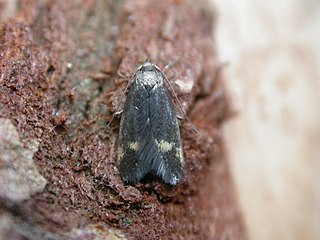
Borkhausenia is a genus of the concealer moth family (Oecophoridae) described by Jacob Hübner in 1825. Among these, it belongs to subfamily Oecophorinae, wherein it is probably closely related to Hofmannophila. In the past, several other Oecophoridae have been included in Borkhausenia, as well as a few even more distant members of the superfamily Gelechioidea. Metalampra was originally described as a subgenus of Borkhausenia. Telechrysis has also been included here as a subgenus by some, while other authors have considered it a separate genus in the Oecophorinae or – if these are also considered distinct – the Amphisbatinae.

The Autostichinae are a subfamily of moths in the superfamily Gelechioidea. Like their relatives therein, their exact relationships are not yet very well resolved. The present lineage was often included in the concealer moth family (Oecophoridae), but alternatively it is united with the Symmocidae sensu stricto to form an expanded family Autostichidae.
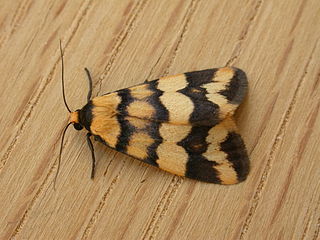
Termessa zonophanes, the double yellow-patched footman, is a moth of the subfamily Arctiinae. The species was first described by Edward Meyrick in 1888. It is known from the Australian Capital Territory, New South Wales, Queensland and Victoria.

Anestia ombrophanes, the clouded footman, is a moth of the subfamily Arctiinae. The species was first described by Edward Meyrick in 1886. It is known from the Australian Capital Territory, New South Wales, Queensland, Western Australia, Victoria and South Australia.

Autosticha is a genus of gelechioid moths. It belongs to the subfamily Autostichinae, which is either placed in the concealer moth family (Oecophoridae), or in an expanded Autostichidae. It is the type genus of its subfamily. Originally, this genus was named Automola, but this name properly refers to a fly genus in family Richardiidae.
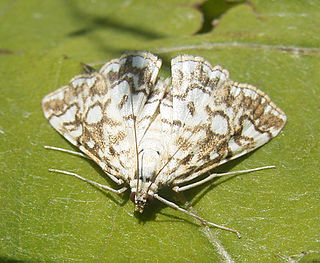
Acentropinae is a fairly small subfamily of the lepidopteran family Crambidae, the crambid snout moths. Species of this subfamily are exclusively found in wetlands and aquatic habitats.
Termessa laeta is a moth in the subfamily Arctiinae. It was described by Francis Walker in 1856. It is found in Australia, where it has been recorded from the Australian Capital Territory, New South Wales, Queensland, South Australia, Victoria and Western Australia.














